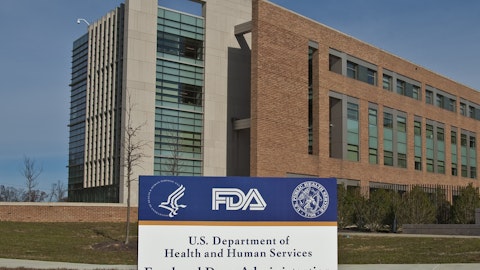Array Biopharma Inc (NASDAQ:ARRY) just had its latest NDA accepted by the FDA, and the agency has put forward a PDUFA date for the candidate of June 30, 2017. The submission completed in June this year, and it’s targeting the approval of Binimetinib in patients with NRAS-mutant melanoma.
For those familiar with the drug already, it’s the one that Novartis AG (ADR) (NYSE:NVS) initially licensed the rights to back in 2010, but for which Array Biopharma Inc (NASDAQ:ARRY) reacquired the rights after Novartis purchased GlaxoSmithKline plc (ADR) (NYSE:GSK)’s oncology segment early last year.
Will Glaxo regret handing back the rights come PDUFA? To answer, we’ve got to look at the drug and the supporting data in an attempt to figure out what the chances of approval are when the drug goes in front of the agency. Here goes.

racorn/Shutterstock.com
The drug in question, Benimitinib, is what’s called an MEK inhibitor. The science behind this one is relatively simple, and is currently being investigated in a host of alteranitive candidates (using similar approaches) all across the pharma space. Right now, however, Benimitinip is one of the front runners. The MEK refered to is one of two enzymes – MEK 1 or MEK 2. Both play a key role in what’s called the MAPK/ERK pathway.
We’ve covered this pathway in quite a lot of detail in the past, but for those not yet familiar with its function, it’s basically the bridge between the receptor on the surface of a cell to the DNA in the cell’s nucleus. It allows for signals to be sent from extra to intra-cellular matter, and these signals carry instructions related to a whole host of things – proliferation, replication, growth, apoptosis, etc.
We don’t really need to go in to the specifics of the MEK enzymes in the process, but it’s what’s important is that the MEK enzymes form a sort of link hallway through the kinase cascade process. This process amplifies the signal and essentially translates it into something usable by the DNA. Without the MEK enzymes, the cascade is highly inefficient, and the message might reach the DNA (although unlikely) but even if it does, it won’t be of any use.
From here, the implications are pretty clear. In cancer cells, this pathway is overactive. This results in excessive replication of the cells in question, and the commonly associated unchecked proliferation of tumor cells.
Inhibition of the MEK enzymes, therefore, should theoretically render and signals sent by way of the over active pathway (and in turn, cascade) useless, and put a check on the unchecked proliferation. Simple.
So how has it performed in trials?
The data on which the application is based was a phase III called NEMO. It was set up to compare Benimitinib with a current SOC antineoplastic chemotherapy drug called Dacarbazine. Both arms dosed once every three weeks, and the trial was randomized to blind the arms to one another. The primary endpoint was progression free survival (PFS) compared to SOC. Median PFS for the active arm came in at 2.8 months, versus 1.5 months for control. In an arm in which patients received a prior course of immunotherapy, before randomization to active or control, PFS for active came in at 5.5 months verses 1.6 months for control.
One note here – the company expects an approval to be based on the primary endpoint, not the immunotherapy treatment results. Why? Because while they seem like great results, it’s very difficult to differentiate between the immunotherapy impact and the active drug impact.
So what are the chances of approval?
Well, PFS was hit, so endpoint met, but there was no stat sig improvement for active over control in overall survival, which might be a stumbling point. The FDA can be very picky when it comes to PFS and OS, and it’s meant the difference between failure and success in the past.
With this said, however, we expect in this instance that the drug has a good chance of approval. This is an unmet need, and any step forward (assuming safety and tolerability are clean/comparable, which in this instance they are) is a bonus for the population.
We’re looking to an advisory panel review as indicative of the agency’s final decision. We don’t yet have a date for the review (we guess it will take place during Q2 next year) but we will update our readers as soon as we find out more.
Follow Array Biopharma Inc (NASDAQ:ARRY)
Follow Array Biopharma Inc (NASDAQ:ARRY)
Note: This article is written by Mark Collins and originally published at Market Exclusive.





